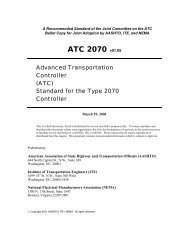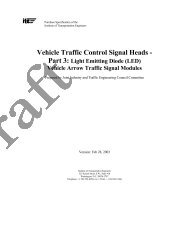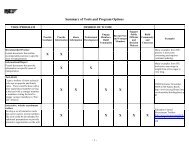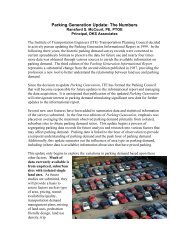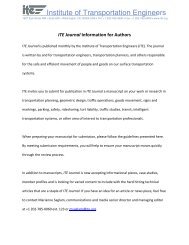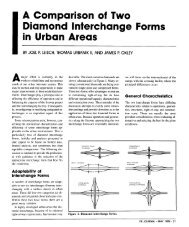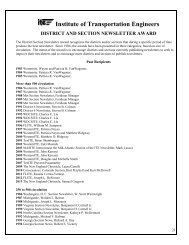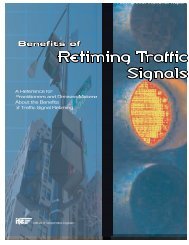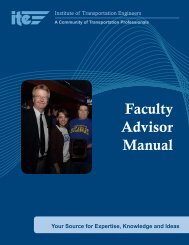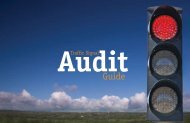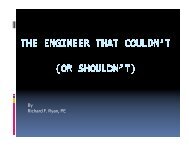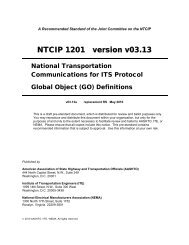Effects on Driver Speeds of In-Lane Rumble Strips on Approaches to ...
Effects on Driver Speeds of In-Lane Rumble Strips on Approaches to ...
Effects on Driver Speeds of In-Lane Rumble Strips on Approaches to ...
You also want an ePaper? Increase the reach of your titles
YUMPU automatically turns print PDFs into web optimized ePapers that Google loves.
CONCLUSIONS<br />
An analysis <strong>of</strong> the speed data collected at the study sites reveals small changes in mean and 85 th<br />
percentile speed <strong>on</strong> approaches with rumble strips. <strong>In</strong> some cases the change was an increase in<br />
speeds and at other sites the change was a decrease in speeds <strong>on</strong> the approach <strong>to</strong> the intersecti<strong>on</strong>.<br />
Generally, the speed changes were less than 4 mph (6.4 km/h), with most being <strong>on</strong> the order <strong>of</strong> 1<br />
<strong>to</strong> 2 mph (1.6 <strong>to</strong> 3.2 km/h). Statistical tests revealed that many, but not all, differences in mean<br />
speeds at each site were statistically significant at the 95 th percent level <strong>of</strong> c<strong>on</strong>fidence.<br />
An analysis was performed <strong>on</strong> a subset <strong>of</strong> five sites that had similar rumble strip installati<strong>on</strong>s.<br />
The speed data were c<strong>on</strong>solidated using the first rumble strip that a driver would encounter as the<br />
comm<strong>on</strong> point between the five sites. For each locati<strong>on</strong> al<strong>on</strong>g the speed pr<strong>of</strong>ile with a difference<br />
in speed greater than 1.0 mph (1.6 km/h), which is the limit <strong>of</strong> the speed measuring equipment,<br />
speeds were lower in the after period. The decrease in speeds ranged from 1.4 <strong>to</strong> 5.0 mph (2.3 <strong>to</strong><br />
8.0 km/h). The statistical test found that all differences in mean speeds were statistically<br />
significant for the speed pr<strong>of</strong>ile.<br />
ACKNOWLEDGEMENTS<br />
The research described in this paper was performed by the Texas Transportati<strong>on</strong> <strong>In</strong>stitute as part<br />
<strong>of</strong> a research project sp<strong>on</strong>sored by the Texas Department <strong>of</strong> Transportati<strong>on</strong> (Project Number 0-<br />
4278: Safety Measures for Rural <strong>In</strong>tersecti<strong>on</strong>s). The c<strong>on</strong>tents <strong>of</strong> this paper reflect the views <strong>of</strong><br />
the authors, who are resp<strong>on</strong>sible for the facts and accuracy <strong>of</strong> the data presented herein. The<br />
c<strong>on</strong>tents do not necessarily reflect the <strong>of</strong>ficial views or policies <strong>of</strong> the Texas Department <strong>of</strong><br />
Transportati<strong>on</strong>.<br />
REFERENCES<br />
1 Walt<strong>on</strong>, S., and E. Meyer. “The Effect <strong>of</strong> <strong>Rumble</strong> Strip C<strong>on</strong>figurati<strong>on</strong> <strong>on</strong> Sound and<br />
Vibrati<strong>on</strong> Levels.” ITE Journal, December 2002. pp. 28-32.<br />
2 Zaidel, D., A.S. Hakkert, and R. Barkan. “<strong>Rumble</strong> <strong>Strips</strong> and Paint Stripes at a Rural<br />
<strong>In</strong>tersecti<strong>on</strong>.” Transportati<strong>on</strong> Research Record 1069, Transportati<strong>on</strong> Research Board,<br />
Nati<strong>on</strong>al Research Council, Washingt<strong>on</strong> D.C., September 1986. pp. 7-13.<br />
3 Harwood, D.W. “Use <strong>of</strong> <strong>Rumble</strong> <strong>Strips</strong> <strong>to</strong> Enhance Safety.” Synthesis <strong>of</strong> Highway Practice<br />
191, Nati<strong>on</strong>al Cooperative Highway Research Program, Nati<strong>on</strong>al Academy Press,<br />
Washingt<strong>on</strong>, D.C., 1993.



